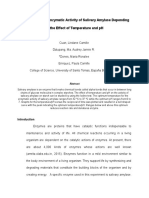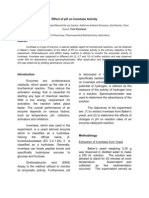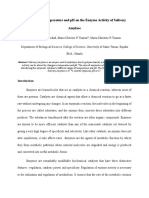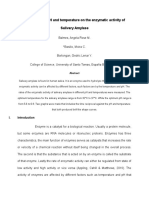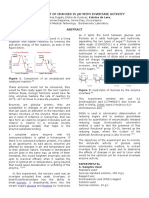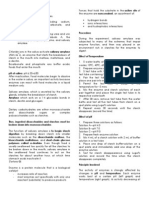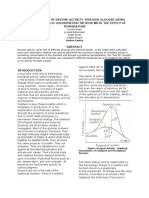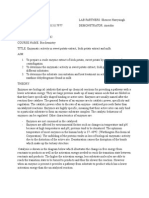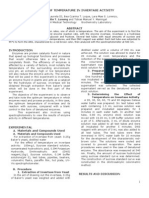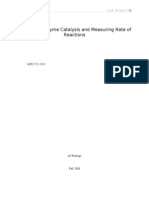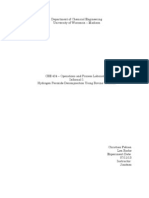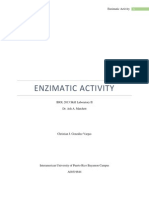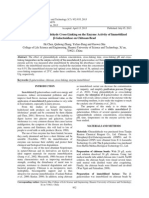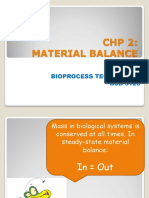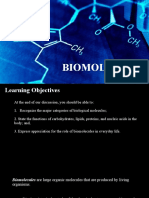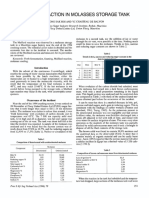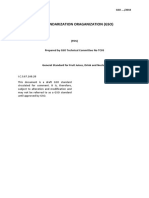Effect of PH On Invertase Activity
Effect of PH On Invertase Activity
Uploaded by
tancmielleCopyright:
Available Formats
Effect of PH On Invertase Activity
Effect of PH On Invertase Activity
Uploaded by
tancmielleOriginal Description:
Original Title
Copyright
Available Formats
Share this document
Did you find this document useful?
Is this content inappropriate?
Copyright:
Available Formats
Effect of PH On Invertase Activity
Effect of PH On Invertase Activity
Uploaded by
tancmielleCopyright:
Available Formats
Effect of pH on Invertase Activity Subijano, M.G., Silva, J.A., Sunglao, A.J., Supan, E.J., Tan, C.M., Tayag, P.
I Group no. 7, 2G Medical Technology, Faculty of Pharmacy, UST
ABSTRACT
INTRODUCTION Living systems control their activities through enzymes. An enzyme is a protein molecule that is a biological catalyst bearing three essential characteristics. First, the most fundamental of its function is to speed up the rate of reaction. Most cellular reactions take place many times faster than they would in the absence of an enzyme. Second, most enzymes act specifically with only one reactant, called substrate, to produce products. The third and the most notable characteristic an enzyme is that enzymes are regulated from a state of low activity to high activity or vice versa.[1] Enzymes accelerate biochemical reactions by physically interacting to reactants and products to provide a more favorable pathway for the transformation of one to another. They increase the rates of reactions by increasing the probability of the reactant can interact properly. But no matter how reactants increase the rate of a reaction, they cannot promote reactions where G is positive or non-spontaneous reaction.[2] Since enzymes are proteins, they are very sensitive to changes in pH. Each enzyme has its own optimum range where it will be most active. Several factors are influenced directly by the pH in which the reaction takes place: The binding of substrate to the enzyme, the ionization \the catalytic activity of the enzyme, the ionization of the substrate and variation in the protein structure at extreme pH.
Fig. 1 Graph of enzymatic activity against pH
The graph indicated above is described as the bell-shaped curve. It indicates the situation wherein the enzyme works at it best at a particular pH, which is called the optimum pH. Take note that shape of the graph can be altered as changes in pH occur. [3] Temperature can affect an enzyme in two ways. One is a direct influence on the reaction rate constant, and the other is in thermal denaturation of the enzyme at elevated temperatures. To relate the effect of temperature to the reaction rate constant, the Arrhenius equation is used: where k is the rate constant, R is the gas law constant, A is the frequency factor and Ea is the activation energy of the
reaction. The temperature ranges over which enzymes show activity is limited between the melting point (0oC) and boiling point (100oC) of water. If a temperature is too low, there can be no noticeable reaction rate since the enzyme is operating at a temperature far below its optimum. If the temperature at which the enzyme is operating at is well above 100oC, then thermal deactivation can occur.
fructose. Dinitrosalicylic colorimetric method is used to test the presence of free carbonyl group (C=O), the so-called reducing sugars. This involves the oxidation of the aldehyde functional group present in, for example, glucose and the ketone functional group. 3,5-dinitrosalicylic acid is the (yellow) reagent used to determine the sugar content of the given Invertase. However in some instances, glucose can also be used directly in the experiment to save time. [6] The spectrophotometer is an instrument which measures the amount of light of a specified wavelength which passes through a medium. According to Beer's law, the amount of light absorbed by a medium is proportional to the concentration of the absorbing material or solute present. Absorbency is indicated with a capital A. [7] In this experiment, the spectrophotometer was employed to measure the absorbance of Invertase which was plotted against values of the amount of acid-hydrolyzed sucrose to come up with the standard calibration curve which will be the basis for the construction of pH vs. amount of glucose. The objectives include, a.) To extract Invertase from Bakers yeast. b.) To determine the effects of changes in pH and temperature on reaction rates of an enzyme catalyzed reaction. Given the objectives, the experiment was successfully achieved. EXPERIMENTAL A. Samples used Glucose and 3,5-dinitrosalicylic acid. B. Procedure 1. Extraction of Invertase From Yeast Invertase was extracted by dissolving the 0.25g Bakers yeast in distilled water to make a 250 mL solution. Then it was allowed to stand for 20 minutes at a room temperature, allow the solution to settle. If sedimentation occurs, collect the supernatant. The supernatant
Fig 2 Graph of enzymatic activity against Temperature
Sucrose, commonly known as table sugar, is a disaccharide composed of an alpha-D-glucose molecule and a beta-Dfructose molecule linked by an alpha-1,4glycosidic bond. When this bond is cleaved in a hydrolysis reaction, an equimolar mixture of glucose and fructose is generated. This mixture of monosaccharide [4] is called invert sugar. Thereby, dextrorotatory saccharose is transformed to levorotatory variety. [5] Sucrose can be catalyzed in the presence of an enzyme named Invertase or sucrose. Invertase is classified as a hydrolase which basically conducts hydrolysis reactions. The systematic name for the invertase is fructofuranosidase (EC3.2.1.26), which implies that the reaction catalyzed by this enzyme is the hydrolysis of the terminal nonreducing -fructofuranoside residues in -fructofuranosides. [4] In this experiment, the invertase was isolated from the Bakers yeast and is subjected to hydrolysis to form glucose and
serves as the enzyme stock solution that will be used for the succeeding experiments. 2. Preparation of Denatured Invertase Stock Solution Incubate an amount of 100mL enzyme stock solution in a boiling water bath for 10 minutes. Allow the solution to cool the collect only the supernatant if frothing occurs. 3. Preparation of Standard Glucose Prepare a working standard solution by diluting 1.80mL 1% glucose solution with distilled water amounting 1.20mL in a test tube. 4. Effect of pH on Invertase Activity Prepare 3 test tubes having two samples of 0.50mL enzyme stock solution and one 0.50mL denatured stock solution. On the same given test tubes bearing the enzymes, accurately pipette a quantity of 1mL buffer solution (the group used Phosphate buffer with a pH of 8.00) and 1.50mL glucose solution. Mix well the solution then heat in water bath for 15 minutes at 60C. After heating in water bath, add 3.0mL DNS reagent and heat the solution again for 10 minutes at 95C. Allow the test tubes to cool at room temperature. The absorbance of the test tubes was measured at 540nm. Another set of test tubes were prepared using 0.1 mL of distilled water instead of denatured enzyme stock solution. The latter solutions served as blank solution for calibrating the spectrophotometer. 5. Effects of Invertase on Temperature
Prepare 3 test tubes having two samples of 0.50mL enzyme stock solution and one 0.50mL denatured stock solution. On the same given test tubes bearing the enzymes, accurately pipette a quantity of 1mL buffer solution at pH 5.00 and 1.50mL glucose solution. Heat to water bath for 15 minutes at 95C and after which add 3mL DNS reagent then heat to water bath again for 15 minutes and let it cool down at room temperature after the last water bath. RESULTS AND DISCUSSION Effect of pH on Invertase Activity The slope-intercept form obtained from the standard calibration curve was used to calculate the amount of acid-hydrolyzed sucrose using varied pH values. The formula used was where y is the absorbance, b is intercept and m is the slope.
You might also like
- Enzyme Kinetics Lab ReportDocument20 pagesEnzyme Kinetics Lab ReportYasmin Lau100% (2)
- Effect of PH On Invertase ActivityDocument4 pagesEffect of PH On Invertase ActivityMa. Ellah Patricia M. GutierrezNo ratings yet
- Determination of Enzymatic Activity of Salivary Amylase Depending On The Effect of Temperature and PHDocument11 pagesDetermination of Enzymatic Activity of Salivary Amylase Depending On The Effect of Temperature and PHAmberValentineNo ratings yet
- BIOCHEM LAB - Enzymatic Activity of Salivary AmylaseDocument6 pagesBIOCHEM LAB - Enzymatic Activity of Salivary AmylaseIsmael Cortez100% (2)
- Enzymati Activity of Salivary AmylaseDocument4 pagesEnzymati Activity of Salivary AmylaseRoy Ruby Caberoy100% (1)
- Social Teachings of The ChurchDocument22 pagesSocial Teachings of The Churchtancmielle100% (1)
- Broadcasting ScriptDocument3 pagesBroadcasting Scripttancmielle59% (54)
- FP 313 Fruits and Vegetables Processing TechnologyDocument120 pagesFP 313 Fruits and Vegetables Processing TechnologyRichard Simon Kisitu100% (2)
- Food AdditivesDocument15 pagesFood AdditivesrameshbptlNo ratings yet
- Isolation of Invertase PHDocument4 pagesIsolation of Invertase PHJohn Mark Flores VillenaNo ratings yet
- Enzymes Formal ReportDocument5 pagesEnzymes Formal ReportLian Phillip DonatoNo ratings yet
- Effect of Temp On EnzymesDocument3 pagesEffect of Temp On EnzymesJanick MallareNo ratings yet
- Effect of PH On EnzymesDocument3 pagesEffect of PH On EnzymesJanick MallareNo ratings yet
- Enzymes Formal ReportDocument4 pagesEnzymes Formal ReportJenelle Jane Quilaneta75% (4)
- Enzymes and Effects of PHDocument4 pagesEnzymes and Effects of PHSeph Cordova50% (2)
- Enzymes: Biological CatalystsDocument9 pagesEnzymes: Biological CatalystsChamzelleNo ratings yet
- Kinetic Properties of β-glucosidase/ Cellobiase from Aspergillus NigerDocument20 pagesKinetic Properties of β-glucosidase/ Cellobiase from Aspergillus Nigerapi-340517298No ratings yet
- Determination of Enzyme Activity Through Glucose Using Picric Acid Method, PH and Temperature (2EMT - Group 1, 2010)Document6 pagesDetermination of Enzyme Activity Through Glucose Using Picric Acid Method, PH and Temperature (2EMT - Group 1, 2010)Mary ChristelleNo ratings yet
- Isolation of ProteinDocument3 pagesIsolation of ProteinReysa Gabrielle PileNo ratings yet
- BiochemDocument4 pagesBiochemJohnvee MaganaNo ratings yet
- Extraction of Invertase From Yeast and Effect of PH On Invertase ActivityDocument6 pagesExtraction of Invertase From Yeast and Effect of PH On Invertase ActivityBea Trixia GalesNo ratings yet
- Effect of PH On Invertase ActivityDocument4 pagesEffect of PH On Invertase ActivityToni Sy Encinares100% (2)
- The Effects of Temperature and PH On The Enzyme Activity of Salivary AmylaseDocument9 pagesThe Effects of Temperature and PH On The Enzyme Activity of Salivary AmylaseCherisse TuazonNo ratings yet
- Enyzmatic Activity of Salivary AmylaseDocument6 pagesEnyzmatic Activity of Salivary AmylaseGio Punsalan50% (2)
- The Extraction of Invertase From Yeast and Its Effects On PH and TemperatureDocument5 pagesThe Extraction of Invertase From Yeast and Its Effects On PH and TemperatureDeanne Louise Dela Cruz100% (2)
- Effect of PH On The Activity of Denatured and Non-Denatured Invertase From Baker's YeastDocument7 pagesEffect of PH On The Activity of Denatured and Non-Denatured Invertase From Baker's YeastEilleen SagunNo ratings yet
- The Effects of PH and Temperature On The Enzymatic Activity of Salivary AmylaseDocument9 pagesThe Effects of PH and Temperature On The Enzymatic Activity of Salivary AmylaseMoira Mochie C. BasilioNo ratings yet
- Exp 6 Formal Lab Report 113BDocument14 pagesExp 6 Formal Lab Report 113BAlaina Weinheimer100% (3)
- Enzyme ExperimentDocument6 pagesEnzyme ExperimentBill HarleyNo ratings yet
- Beano LabDocument12 pagesBeano Labapi-284496286No ratings yet
- Formal Report Expt 3 EnzymesDocument4 pagesFormal Report Expt 3 EnzymesKat De LaraNo ratings yet
- EnzymesDocument5 pagesEnzymesjimmer9No ratings yet
- Factors Affecting Starch DigestionDocument2 pagesFactors Affecting Starch DigestionNikki Ticman100% (1)
- Chemistry Individual InvestigationDocument14 pagesChemistry Individual InvestigationAdrien G. S. WaldNo ratings yet
- Test Instructions For Measuring The Microbial Metabolic Activity in Water Samples - ObstDocument3 pagesTest Instructions For Measuring The Microbial Metabolic Activity in Water Samples - ObstgotcanNo ratings yet
- Lab 13 Enzymes Reading PDFDocument8 pagesLab 13 Enzymes Reading PDFLarryDengNo ratings yet
- Formal Report BiochemDocument6 pagesFormal Report Biochemjoshua_naruto100% (1)
- Extraction of InvertaseDocument5 pagesExtraction of InvertaseDianne Joy Pascua100% (1)
- Formal Report2Document5 pagesFormal Report2Krisha VittoNo ratings yet
- Chemistry HHWDocument4 pagesChemistry HHWdhairyag1234567890No ratings yet
- Phosphatase EnzymeDocument12 pagesPhosphatase Enzymekab560No ratings yet
- Enzyme Biochem Lab KGDocument13 pagesEnzyme Biochem Lab KGKimberly George-Balgobin50% (2)
- Formal Report Experiment 3 EnzymesDocument4 pagesFormal Report Experiment 3 EnzymesMonica Gamboa100% (3)
- Formal Report Experiment 3 EnzymesDocument4 pagesFormal Report Experiment 3 Enzymesliezl_alvarez_1No ratings yet
- Formalreport INVERTASEDocument2 pagesFormalreport INVERTASEyamsytron50% (4)
- Enzyme Activity and AssaysDocument6 pagesEnzyme Activity and Assaysapi-318629889No ratings yet
- LactosacarosaDocument8 pagesLactosacarosaAriel plutarco cardoso herreraNo ratings yet
- Observing Enzyme Catalysis and Measuring Rate of Reactions: Lab ReportDocument16 pagesObserving Enzyme Catalysis and Measuring Rate of Reactions: Lab ReportArjun NaikNo ratings yet
- Enzymes Lab ReportDocument10 pagesEnzymes Lab ReportSatvika BejawarNo ratings yet
- Effect of PH On Invertase Activity Banayo, Lorenzo S. and Belleca, Keith ADocument3 pagesEffect of PH On Invertase Activity Banayo, Lorenzo S. and Belleca, Keith AlorenzoNo ratings yet
- Biology Coursework Enzymes ConclusionDocument4 pagesBiology Coursework Enzymes Conclusionafaydebwo100% (2)
- Observing Enzyme Catalysis and Measuring Rate ofDocument16 pagesObserving Enzyme Catalysis and Measuring Rate ofGabrielNo ratings yet
- Core Practical 4 Enzyme Concentration For BiologyDocument7 pagesCore Practical 4 Enzyme Concentration For BiologyMitullesh EngarshalNo ratings yet
- Hydrogen Peroxide DecompositionDocument17 pagesHydrogen Peroxide DecompositionChristian Eduardo Fabian50% (2)
- Catalytic Activity of Denatured InvertaseDocument3 pagesCatalytic Activity of Denatured InvertaseKoleen ChavezNo ratings yet
- Enzymatic ActivityDocument15 pagesEnzymatic ActivityChristian J. GonzálezNo ratings yet
- The Effect of Glutaraldehyde Cross-Linking on the Enzyme Activity of Immobilized β-Galactosidase on Chitosan BeadDocument4 pagesThe Effect of Glutaraldehyde Cross-Linking on the Enzyme Activity of Immobilized β-Galactosidase on Chitosan BeadJessica JuliethNo ratings yet
- The Effect of Pancreatic Amylase Concentration and PH On Carbohydrate Digestion and Glucose MetabolismDocument12 pagesThe Effect of Pancreatic Amylase Concentration and PH On Carbohydrate Digestion and Glucose MetabolismdeannamaharajNo ratings yet
- Ap Bio Enzyme Catalase Lab Ap 1Document16 pagesAp Bio Enzyme Catalase Lab Ap 1api-233187566100% (1)
- MODULE Gen. BioDocument15 pagesMODULE Gen. BioLynette Pauline BrofarNo ratings yet
- Experimental approaches to Biopharmaceutics and PharmacokineticsFrom EverandExperimental approaches to Biopharmaceutics and PharmacokineticsNo ratings yet
- Oligonucleotide-Based Drugs and Therapeutics: Preclinical and Clinical Considerations for DevelopmentFrom EverandOligonucleotide-Based Drugs and Therapeutics: Preclinical and Clinical Considerations for DevelopmentNicolay FerrariNo ratings yet
- ML Standard: 0.25 ML H2O: 1.25 Total ML Is 1.50: ST RD THDocument2 pagesML Standard: 0.25 ML H2O: 1.25 Total ML Is 1.50: ST RD THtancmielleNo ratings yet
- English 4 (Speech)Document20 pagesEnglish 4 (Speech)tancmielleNo ratings yet
- Experiment 8 Org Chem Formal ReportDocument4 pagesExperiment 8 Org Chem Formal ReporttancmielleNo ratings yet
- Noli Me Tanger and El FilibusterismoDocument8 pagesNoli Me Tanger and El Filibusterismotancmielle100% (1)
- Effect of Sucrose Concentration On The Products of Kombucha Fermentation On MolassesDocument7 pagesEffect of Sucrose Concentration On The Products of Kombucha Fermentation On MolassesNayeli MartinezNo ratings yet
- B) Chocolate (Same) C) Non - Chocolate Confectionary ProductDocument33 pagesB) Chocolate (Same) C) Non - Chocolate Confectionary ProductMickey Singh100% (1)
- Overripe Banana SweetenerDocument5 pagesOverripe Banana SweetenerJulieann YacubNo ratings yet
- Chapter 2 Material Balance FazlieditedDocument36 pagesChapter 2 Material Balance FazlieditedThivya KarthigayanNo ratings yet
- Dattaproject DONEDocument25 pagesDattaproject DONEsumit potdarNo ratings yet
- Laboratory Report:: Qualitative Test For CarbohydratesDocument15 pagesLaboratory Report:: Qualitative Test For CarbohydratesivyNo ratings yet
- About IcumsaDocument2 pagesAbout IcumsabvsundarNo ratings yet
- G10 Lesson of BIOMOLECULES - Carbohydrates POWERPOINTDocument17 pagesG10 Lesson of BIOMOLECULES - Carbohydrates POWERPOINTlyaffleNo ratings yet
- Zodiac Maritime Agencies Ltd. Chemical Operations Manual: Contents - SC 9 MolassesDocument4 pagesZodiac Maritime Agencies Ltd. Chemical Operations Manual: Contents - SC 9 MolassesRahulPrakashNo ratings yet
- Drying Crystallization SucroseDocument6 pagesDrying Crystallization SucrosemarcogiuliettiNo ratings yet
- Jayabalan Et Al-2014-Comprehensive Reviews in Food Science and Food Safety PDFDocument13 pagesJayabalan Et Al-2014-Comprehensive Reviews in Food Science and Food Safety PDFFarhana AnuarNo ratings yet
- BioChem - Experiment 3-Post LabDocument12 pagesBioChem - Experiment 3-Post LabAllyzha AguilarNo ratings yet
- 1996 - Wong Sak Hoi Maillard Reaction in MolassesDocument4 pages1996 - Wong Sak Hoi Maillard Reaction in MolassesRaymund GatocNo ratings yet
- CRAPISTE J.E. LOZANO - Effect of Concentration and Pressure On The Boiling PointDocument4 pagesCRAPISTE J.E. LOZANO - Effect of Concentration and Pressure On The Boiling PointCarla Gallegos0% (1)
- Quiz 1 - InferenceDocument16 pagesQuiz 1 - Inferencevasuca2007No ratings yet
- Optimal Particle Size Distribution of White Sugar: Optimálizácia Rozdelenia Častíc Bieleho CukruDocument7 pagesOptimal Particle Size Distribution of White Sugar: Optimálizácia Rozdelenia Častíc Bieleho CukruClifford Dwight RicanorNo ratings yet
- Elizabeth Baldwin SeminarDocument1 pageElizabeth Baldwin SeminarAnonymous tGJ2lopsNo ratings yet
- Physiology of The Digestive System: Column A Column BDocument4 pagesPhysiology of The Digestive System: Column A Column BJonash MoralesNo ratings yet
- Are432 en 1 1 PDFDocument22 pagesAre432 en 1 1 PDFfaNo ratings yet
- Enzymes Test C05 SEDocument7 pagesEnzymes Test C05 SEneetiNo ratings yet
- Biochem 7Document14 pagesBiochem 7Clint Danniel GuarinNo ratings yet
- Doherty2011 - Improved Sugar Cane Juice CL by Understanding CalciumOxide-Phosphate-Sucrose SysDocument8 pagesDoherty2011 - Improved Sugar Cane Juice CL by Understanding CalciumOxide-Phosphate-Sucrose SysMolly0630No ratings yet
- Lecture - 9 Economic ImportanceDocument30 pagesLecture - 9 Economic ImportanceSonicca ReyesNo ratings yet
- Food Industry I To 13Document758 pagesFood Industry I To 13ابراهيم القويعىNo ratings yet
- Western Sugar Cooperative, Et Al. v. Archer-Daniels-Midland Company, Et Al.: ComplaintDocument21 pagesWestern Sugar Cooperative, Et Al. v. Archer-Daniels-Midland Company, Et Al.: ComplaintFindLawNo ratings yet
- (Near-Final) PNPM Updated Users Guide - As of March252024Document41 pages(Near-Final) PNPM Updated Users Guide - As of March252024Princess Angie GonzalesNo ratings yet
- Calculate Fructose IntakeDocument3 pagesCalculate Fructose IntakeMahandran ManokarathasNo ratings yet
- Assignment PolarimeterDocument4 pagesAssignment Polarimeterdua krNo ratings yet


